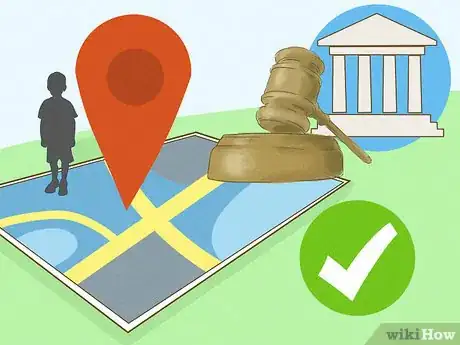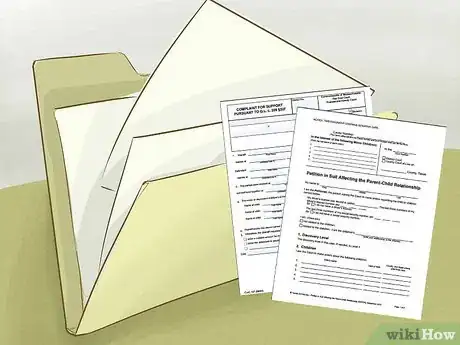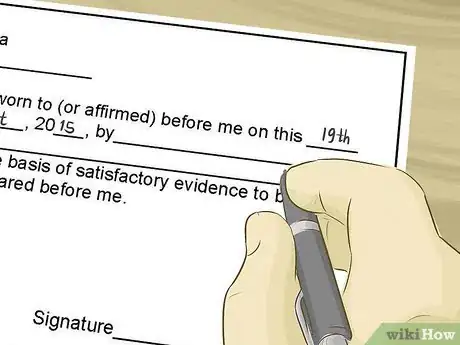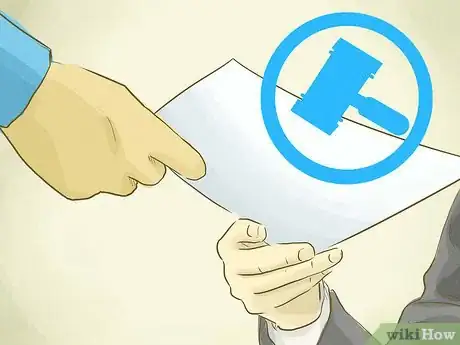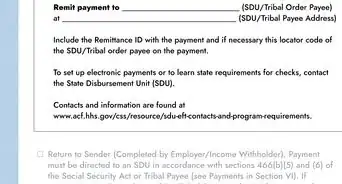This article was co-authored by Clinton M. Sandvick, JD, PhD. Clinton M. Sandvick worked as a civil litigator in California for over 7 years. He received his JD from the University of Wisconsin-Madison in 1998 and his PhD in American History from the University of Oregon in 2013.
There are 11 references cited in this article, which can be found at the bottom of the page.
This article has been viewed 60,482 times.
In Texas, child support is calculated based on the income of the non-custodial parent. There are certain things that will trigger the state to file for and collect child support on your behalf. However, it is usually necessary that you file for child support on your own. Fortunately, with a little preparation, you can do so easily.
Steps
Preparing to File
-
1Contact the Attorney General, if necessary. In some situations, the Office of the Attorney General will file for child support on your behalf. Applying for public assistance to help support the children will automatically trigger the state to file for child support on your behalf, including establishing paternity if necessary.[1] If you have received public assistance, then contact the Office of the Attorney General to start a petition for child support.
- Find your local Child Support Division office by visiting this website.
-
2Get an estimate of your support amount. In Texas, child support is calculated based on a formula that considers the income and certain expenses of the non-custodial parent. The non-custodial parent must pay support until the child is 18 or graduates high school, whichever is later.
- Child support is calculated as a percentage of the non-custodial parent’s net income. The percentage is 20% for one child and then an additional 5% for each additional child (up to 40% for five or more children). Net income includes wages, salary, tips, and self-employed income; rental income; retirement and disability income, as well as any alimony. It does not include income from a new spouse.
- You can also use the Child Support Calculator here to get an estimate of the amount you could receive.
Advertisement -
3Consider meeting with a lawyer. Applying for child support can be a stressful experience, as you need the resources and may have difficulty tracking down the other parent. An experienced family law attorney can be a steady sounding board during this time. An attorney can help you figure out if you qualify for child support and the likely amount you will receive.
- To find a family law attorney, you should call the Lawyer Referral Information Service 1-800-353-9690.
- If costs are a concern, be aware that some attorneys now provide "unbundled" services and will offer “limited scope representation.” Under this arrangement, the attorney will do discrete tasks (such as file a document or give advice).
-
4Establish paternity. If you are seeking child support from the father, then you need to be sure that paternity has been established. Paternity can be established by presumption, by voluntary acknowledgement, or by court order.
- A man is presumed to be the father when he is married to the child’s mother when the child was born, was married to the mother at any point during the 300 days before the child was born, married the mother after the child was born and voluntarily claimed paternity of the child with the Vital Statistics Unit, or continuously lived with the child for the first two years of the child’s life and held the child out as his own.
- If a man signs a legal form, swearing that he is the father, then he will be treated as the legal father if the mother also signs the acknowledgement. However, if there is also a “presumed” father, then the presumed father must sign a Denial of Paternity form.
- Paternity can also be determined by a court. You will initiate the suit by filing a Petition to Adjudicate Parentage. Then you must serve the petition on the man you believe is the father. The man may ask for a DNA test if he denies parentage.[2] You can find the forms at this website.
Filing for an Initial Order
-
1Locate the appropriate court. You must file a motion for child support in the county where the child lives. If you live in another state with the child, and the non-custodial parent lives in Texas, then file in the county where the other parent lives.
-
2Find the correct petition form. You can use a petition form to file for child support. You can visit Texaslawhelp.org to find printable forms. Search under the “Texas Forms” tab, then “DIY printable forms” and then under "Suits Affecting the Parent-Child Relationship."
- Here is the printable Petition form.
- If you are seeking child support as part of a divorce, then a form will be included in your divorce packet.[3]
- You should also read the instructions for filling out the form.
- Do not use this form if the child is disabled. Instead, speak to a lawyer about the proper way to bring a support suit.
-
3Get other applicable forms. In addition to the form petition, you may also need other forms. You can download these as well:
- Information on Suit Affecting the Family Relationship.
- Income Withholding Order. Federal law provides that immediate income withholding will be included in all child support orders unless the parents agree otherwise.[4] If you are worried that the other parent might not pay, then you should insist on having income withheld.
- Out-of-State Party Affidavit (if the other parent lives out of state).
-
4Fill out the forms. The petition form will require the full names of each child, their date of birth, your name, your driver’s license number and Social Security Number, and the name and address of the other parent.[5]
-
5Sign the forms. Once you have completed the forms, you should prepare for filing. Some forms may need to be signed in front of a notary. If so, do not sign until you appear before the notary.
- Notaries are available in banks and in courthouses. You will need to present sufficient personal identification (usually a valid driver's license or passport).
-
6File the forms. Make several copies for yourself (and one for the other parent) before taking all forms to the court clerk, where you will file. Have the court clerk stamp all of your copies with the date. The clerk will also tell you the “cause number” and the “court number,” which you will write on the petition. Tell the clerk you wish to file the forms.
- Be prepared to pay a filing fee. The fee will probably run over $200. If you cannot afford the fee, then ask for an Affidavit of Indigency and fill it out. You must sign it in front of a notary.
-
7Serve the other parent. You need to send a copy of your motion to the other parent. There are three ways you can give legal notice:
- By agreement. The other parent may agree to waive service. He or she will have to fill out a waiver of service form to that effect. This form must be signed in front of a notary at least one day after you file the petition. The other parent may also waive service simply by answering the petition.
- By personal service. For a fee, you can have either the sheriff or private process server deliver the papers. Tell the clerk you want service done in this manner, and the clerk will print off a citation. The citation is attached to the petition. You then send the packet to the sheriff or process server in the county where the other parent lives. The clerk can help you arrange this. After service is made, the server will complete a Return of Service form stating the other parent was served. You must file this Return of Service form with the court clerk.
- By publication. Give notice by publication when you can’t find the other parent. First, the law requires that you perform a “diligent” search. You must also sign an Affidavit to the effect that you have searched diligently for the other parent. Then you must go to the clerk and ask the clerk to issue a citation by publication. You then must ask the clerk to send the citation to the newspaper in the county where you filed your case. Be prepared to pay for the newspaper publication.
-
8Hire an attorney ad litem, if necessary. If you cannot locate the other parent, then you must hire an attorney ad litem. This person will do an independent search for the other parent. You must hire an attorney ad litem when you serve notice by publication.
- If you cannot find the absent parent, then you should contact the Texas Attorney General’s Office. The office will search for absent parents as well as prove paternity and get an initial child custody order.[6]
- To use the services offered by the state, you will need to pay $25 a year for every year you receive at least $500 in support payments.[7]
-
9Send a copy to the state Attorney General. If your child currently receives (or has received in the past) either Medicaid or Temporary Aid for Needy Families, then send a copy of the petition to the Office of the Attorney General Child Support Division.
- Mail the petition to Office of the Attorney General, Child Support Division, P.O. Box 12017, Austin, TX 78711-2017.
-
10Receive payments. Child support payments may be made periodically (weekly, biweekly, or monthly) or in a lump sum. The court may also require the non-custodial parent to purchase an annuity or set aside property. Periodic payments, if ordered, will be made to the state’s Child Support State Disbursement Unit, who then forwards payments to the custodial parent.[8]
- Custodial parents can receive payments by direct deposit into a bank account or onto their Texas Debit Card.[9]
- The judge will set the start date for payments. The judge may also order retroactive child support payments for the period of time between the parents separating and the date a formal child support order is entered.[10]
- Whether or not retroactive child support is ordered will depend on a variety of factors, including whether or not the father knew of his paternity, the resources of the non-custodial parent, and the non-custodial parents contributions to the food, shelter, and clothing of the child before the child support action was filed.[11]
Enforcing a Child Support Order
-
1Draft a motion. If child support payments have not been made in full, then the non-custodial parent is in “arrears.” The custodial parent can initiate an enforcement action by filing a Motion to Enforce. Your court may have printed “fill in the blank” forms for you to use. Ask the court clerk.
- If no form is available, then you should have an attorney draft a motion or draft one yourself. A motion for enforcement of child support must identify the order violated, state the manner of noncompliance, and state relief requested.[12]
- You must also include the amount owed, the amount the non-custodial parent has paid, and the amount of arrearages.[13]
- You must sign your motion or have your attorney sign.[14]
-
2Contact the Texas Attorney General. Instead of filing your own motion for enforcement, you can contact the Attorney General, whose Child Support Division (CSD) will bring an enforcement action on your behalf. You should work through CSD especially if the non-custodial parent has moved out of state, as CSD can work with agencies in the other state to get payment for you.
- The Attorney General’s office can also help track down a missing parent. To facilitate this process, provide the Child Support Division with the non-custodial parent’s Social Security Number.[15]
- The fee is $25 to use the Attorney General’s Child Support Division services.[16] Given how stressful enforcing a child support order can be, you may want to have the state prosecute your enforcement action for you.
-
3File the motion. If you draft your own motion, you need to file it in the court which issued the initial child support order. You should attach a copy of the original child support order as well as the history of support payments, which you can get from the Disbursement Unit.
-
4Serve notice. You must notify the other parent of the enforcement action. You can use the same method of service of process as you used in your initial support suit.
-
5Attend a hearing. The court will hold an enforcement hearing. Depending on the court, you may get the date of the hearing when you file, or it may be mailed to you. Arrive early and bring copies of your motion and all attachments.
- If your motion was properly prepared with all attachments (history of payments and the original order), then the judge should have a good idea of how much money is owed by the non-custodial parent. Be prepared to affirm what you stated in your motion.
- If the other parent doesn’t attend, the court can issue an arrest warrant.
-
6Receive payment. Judges have several options for collecting arrearages. For example, a court can freeze bank accounts, offset state and federal income tax returns, place a lien on the non-custodial parent's property, and seize and sell property.[19]
- A judge can also revoke state-issued licenses or jail the non-custodial parent for contempt. Think whether or not this is in your best interest. If the non-paying parent loses a license or is jailed, it will be harder for you to collect child support payments.
Warnings
- Typically, a Texas court can order child support only for a child who has lived in Texas for at least the past six month or since birth (if an infant). If this is an issue, then you should talk to a lawyer.⧼thumbs_response⧽
References
- ↑ https://childsupport.oag.state.tx.us/wps/portal/!ut/p/a1/04_Sj9CPykssy0xPLMnMz0vMAfGjzOItDCwsDC1MDLzdLf3NDRz9A9xNvI2cjQw8TIEKIoEKDHAARwNC-r30o9Jz8pPAVkU65iUZW6TrRxWlpqUWpRbplRYBhTNKSgqKrVQNVA3Ky8v10vPz03NS9ZLzc1UNsGnJyC8u0Y9AValfkBtR5ZMa7ggAQhW8Ew!!/dl5/d5/L2dJQSEvUUt3QS80SmlFL1o2XzgwODgxODQwS0c5TzcwQU9QRzRLMkMyMFA3/
- ↑ http://texaslawhelp.org/resource/establishing-paternity-by-court-order
- ↑ http://texaslawhelp.org/resource/do-it-yourself-court-forms-free
- ↑ http://www.acf.hhs.gov/sites/default/files/ocse/handbook_on_cse1.pdf
- ↑ http://texaslawhelp.org/files/685E99A9-A3EB-6584-CA74-137E0474AE2C/attachments/A07C5C99-9829-42B1-81BE-CCEA1E6D355E/sapcr_petition_final.pdf
- ↑ https://www.texasattorneygeneral.gov/faq/cs-parents-frequently-asked-questions
- ↑ https://www.texasattorneygeneral.gov/faq/cs-parents-frequently-asked-questions
- ↑ http://texaslawhelp.org/resource/answers-to-questions-about-child-support-in-t
- ↑ https://www.texasattorneygeneral.gov/cs/cs-forms
- ↑ http://texaslawhelp.org/resource/answers-to-questions-about-child-support-in-t
- ↑ http://texaslawhelp.org/resource/answers-to-questions-about-child-support-in-t
- ↑ http://www.statutes.legis.state.tx.us/Docs/FA/htm/FA.157.htm
- ↑ http://www.statutes.legis.state.tx.us/Docs/FA/htm/FA.157.htm
- ↑ http://www.statutes.legis.state.tx.us/Docs/FA/htm/FA.157.htm
- ↑ http://www.acf.hhs.gov/sites/default/files/ocse/handbook_on_cse1.pdf
- ↑ http://www.acf.hhs.gov/sites/default/files/ocse/handbook_on_cse1.pdf
- ↑ http://www.hcdistrictclerk.com/Common/Civil/pdf/Fee_Schedule_Civil_and_Family.pdf
- ↑ http://access.tarrantcounty.com/content/dam/main/district-clerk/Family_Filing_Fees.pdf
- ↑ http://www.acf.hhs.gov/sites/default/files/ocse/handbook_on_cse1.pdf
About This Article
If you need to file for child support in Texas, first locate a court in the county where the child lives. Next, visit texaslawhelp.org to find printable petition forms and instructions on filling them out. Once you’ve filled out and signed the forms, prepare to file by making several copies for yourself and the other parent. Take the originals to the court clerk, who will file them for a fee that will probably run around $200. After you have officially filed the petition, you will need to give the other parent legal notice and send a copy to the state Attorney General. For more details from our Legal co-author, like how to enforce a child support order, scroll down.




